(12 products available)






















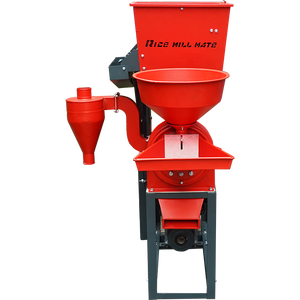









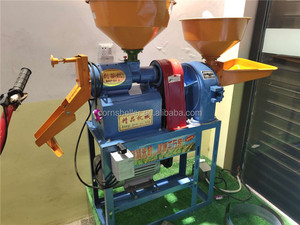




































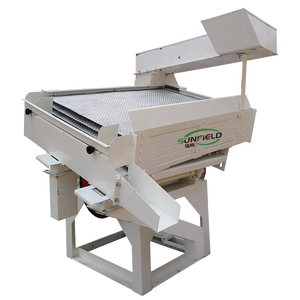
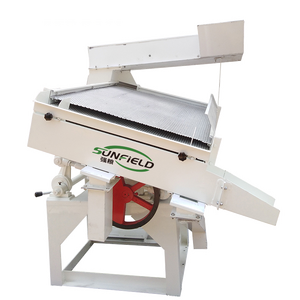
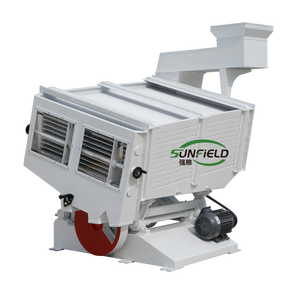
The Satake destoner is part of the Satake rice milling machinery. It has been designed to remove stones and pebbles that are of the same size and shape as rice grains. This can help prevent damage to rice mill equipment and the cooking of inedible objects. Satake's design has relied on differences in weight and specific gravity to separate stones from rice.
The main working principle of a Satake destoner is to use air flow and vibration to separate grains of rice from stones and impurities. The material to be processed is fed onto an air-driven deck, sometimes called a shaking or vibrating table. As air is blown upwards from below the deck, rice and lighter impurities are lifted, while heavier impurities like stones remain on the deck. The direction of the deck's slope and vibration causes the lighter materials to move to the side and be separated. The heavier materials, including stones, are then collected and removed from the deck in a separate container.
There are two main types of Satake Destoners:
This section will provide some specifications and details about the Satake grain destoner's maintenance. Generally, these specifications may vary depending on the specific type and model.
Generally, Satake rice destoner machines are designed for low maintenance and easy use. Some procedures must be followed regularly, which will help ensure that the machine works well for many years.
Attuned to the characteristics and needs of a range of agricultural products, the functional and operational scenarios of the Satake destoner extend across several frontiers of the food industry.
In the rice milling process, the Satake stone remover is essential to separate stones and unwanted materials like glass, metal, and ceramist from harvested rice. Using air and vibration, the machine can discern and separate items of varying densities, including stones of almost identical weight to rice grains, ensuring that only pure, quality rice is processed and produced. Beyond rice, the Satake destoner also finds applications in other cereal processing lines, including wheat, barley, millet, and buckwheat. Grains like these often harbor stones and foreign grains that can damage milling equipment or contaminate final products. The Satake destoner ensures that these uninvited guests are removed before further processing.
The industrial food production sector benefits significantly from the Satake stone remover. Factories that produce rice flour, starch, or other grain-based products must start with clean raw materials. The Satake destoner enables these facilities to produce high-quality end products by eliminating stones, other grains, and debris from the input material.
Restaurants, catering services, and food processing companies use the Satake destoner in the vegetable processing industry. Vegetables such as potatoes, tomatoes, carrots, and bell peppers often contain hidden stones, particularly when sourced from local farms. The Satake vegetable destoner can help prevent costly machinery breakdowns and maintain food safety standards by swiftly removing these stones and unwanted materials.
In grain storage facilities, silos, or warehouses, the Satake stone remover can efficiently remove stones and debris from grains before storing them. This not only helps to maintain the quality of grains over storage periods but also facilitates the cleaning of the stored grains before they are subsequently processed.
Some models of Satake destoners are also used for seed cleaning operations in the agricultural sector. The screening and air-flow principles employed by the Satake destoner can successfully remove stones, weed seeds, and other contaminants that accompany valuable crop seeds, ensuring that only certified, high-quality seeds are distributed to farmers.
Although choosing the right Satake destoner might seem straightforward, the diverse needs of grain processing businesses mean there are several factors to consider before making a purchase. Given the significant investment a stone separator represents, buyers need to be confident that their choice will yield strong performance, efficient operation, and a good return on investment.
Before anything else, it's vital to establish the intended use of the machine. Will it be sorting wheat, rice, corn, cocoa beans, coffee beans, or another kind of grain? The soil types and contaminants that need to be separated should also be taken into account, as some models are better suited to removing certain types of unwanted materials than others. It's essential to review the machine's specifications on the kinds of grains it can handle and its separation efficiency.
The processing capacity required must also be established. The destination chosen should have a processing capacity that matches business needs. Consideration should be given to the amount of grain that needs to be processed daily, and the machine's throughput should match this to avoid bottlenecks in the sorting process.
Room in the grain processing line and the floor space available should also be considered. The chosen destoner should fit into the existing processing line or system and take up a reasonable amount of floor space so that staff and workflows are not disrupted.
The power requirement of the machine should also be in line with that of the processing facility. Typically, grain processing facilities use high-voltage three-phase power, so it's essential to ensure that the destoner's power requirements align with the facility's infrastructure to avoid the need for costly electrical upgrades.
The budget is, of course, an important consideration, and it's good to know that the purchase price isn't the only cost to consider. The operating cost of the stone separator will likely eat up a lot more over the grain processing facility's lifetime. Operating costs include power, maintenance, spare parts, and any additional staff training required to operate the new machinery.
Ultimately, after considering all these factors, business buyers must have confidence in the performance of the stone separator they choose, and it is advisable to check customer reviews of the product in question to see if others have had a good experience.
Q1: What are the advantages of a Satake destoner?
A1: The main advantages of Satake destoners are exceptional grain purity, reliable performance, and high separation efficiency. They are designed to operate with low power consumption while efficiently removing stones and other undesirable heavy impurities from the product.
Q2: What types of stones can the Satake destoner remove?
A2: The Satake destoner machine is specifically designed to detect and eliminate all types of stones that are approximately equal to the size or weight of the cereal grain. The stones may include soil clods and other heavy foreign materials.
Q3: Can a Satake destoner be used for materials other than grains?
A3: Yes. While the Satake destoner is primarily used for processing grains, its separation principle can be applied to other materials such as beans, nuts, non-mineral materials, plastic, and rubber.
Q4: Does a Satake destoner affect the quality of processed grains?
A4: Yes. The presence of stones and other heavy impurities can damage milling equipment and reduce the flour quality of the final product. Therefore, using a Satake grain destoner will improve the quality of processed grains by reducing the amount of heavy impurities.